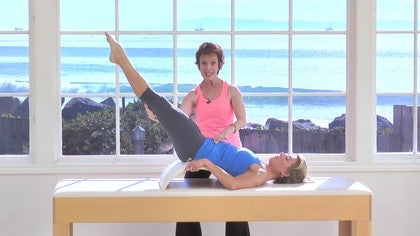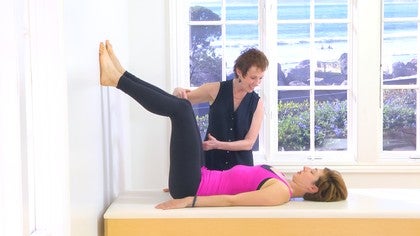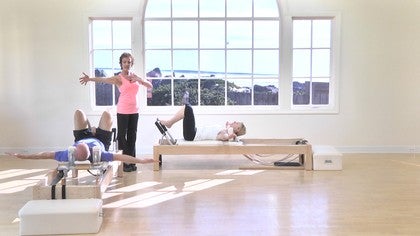Description
About This Video
Transcript
Read Full Transcript
Hi there. I'm Debra Cole away and I'm going to be working with Kristy on the half barrel doing some really lovely release work, stretch work for the shoulders and the chest. And what you'll find is that depending on you, you might have to adjust yourself one way or the other. And I'll explain that relative to what happens with Christie as we go. So go ahead and have a seat. Christie. Sit right in front of the barrel.
Now for some people, if your chest is relatively tight and your shoulders are tight, you may find that when you lay back over the barrel slide all the way forward for me for just a bit, that hardly being over the apex or even lower than where Christie is now is going to be quite a nice stretch. Okay. Someone with a good deal of round childrens this, this is going to be a sufficient opening for your chest and shoulder because of the way that the down slope of the barrel works and you notice I'm holding her head. So for someone in this situation, you might need to pat up quite a bit. I only have this one towel, but you could imagine if you're comfortable here with your knees bent, you could straighten your legs if you want to, but this might be sufficient stretch and obviously we want some support under the head so you'd have to bring essentially the barrel up to meet her head. Having said that, if you don't need to be that low down and you're actually at the point where you're opening your chest and shoulders and getting a little bit of extension in your thoracic spine, then you can walk yourself a little further back on the barrel. In which case you might need less support, but you do definitely want to feel really, really comfortable. You want to feel like you can let, let the throat go, let the neck go and that the back of your head can be heavy, can be relaxed and resting on the barrel, so that's going to be relative to your proportions. Now at the same time, now that we're looking at getting a little bit more potential extension in the thoracic spine, your whole body is extended more.
You don't want to feel like your sacrum is hanging off your lumbar. So again, if you have a little bit more tightness or restriction in your lumbar spine or your hips or tighter, you could play with it this way. You could straighten your legs all together and even though you notice that there is a good deal of space between Christy and the barrel, if she's comfortable, it's really okay. So that's a fine way to do it. And one more alternative that I'll show you is if you bend your knees and actually take a little bit of padding, so is going to lift her pelvis and even walks closer in. Okay. It's almost like you're creating a mini spine corrector. Okay.
So both ends are supported. You can guide your client to gently press into their feet and feel the connection of the femur pressing back into the pelvis to find that support. But that's a little bit more active on their part. And again, you have to decide whether you want this to be more active or really very restorative and very relaxing. So the more restorative and just simply relaxing you want this to be, the more support the equipment has to give you. If you feel like you want to be more active than you can actually employ the strength of your legs essentially to drive the power through the pelvis, up over the spine, to relax the shoulders, the neck and the head.
So you'll figure that out and have some props near you, enough padding so that you can play with it and find your comfort. So the first thing that we're going to do is elbow circles. So Christie, go ahead and put the fingertips on the top of your shoulders. There's no perfect place that you have to be. It's just to remind you that your arms are, are going to be bent. And we're going to completely work with the breath now. So on an exhale, relax all together and imagine your bottom ribs closing.
And literally as the breath comes out, your elbows are drawn together and if you can, you touch them over your chest. So on an inhalation, the spine is lengthening and lifting and the breath fills and opens the chest. The lungs and the shoulders. Keep inhaling as you take the elbows out to the side. If you have the range, you can absolutely rest on the barrel. Exhaling, let the ribs deflate and bring the elbows back down. So time it so that the inhalation lifts and stretches and opens you and widens you. Exhaling, feel the the deflation and allow those elbows to come together.
Now keep going. If you have clicking or popping or cracking or any kind of clunking, you really don't want that. So you're going to have to limit your range and really feel that the breath is what's lifting you. So you wouldn't want a clunk to occur as you take your arms down to the mat. But if it all feels good to you, there you going.
You might even find as you do a couple more, that you have several pads under you and that you don't even need those pads because that's your spine starts to open and your chest and shoulders start to open. Things will release. Exhale as you come back down. Let's do a few in the other direction. So inhaling, allow the ribs to lift and widen, bringing the elbows together at the top. Now on the exhale, release the sternum. Allow those elbows to come back down. And if you want, if you have somebody to help you, they can take and stretch your ribs for you and pull through and then exhale, release down. One of the things that you want to be very careful about, you're going to partner is that you never pull the person's arms behind them, but just in line with the apex of the barrel, exhaling, come back down to just do one more. Breathing in, really feeling that gorgeous, wonderful stretch of the rib cage away from the lower spine. You can use your hands to massage and open up those tight muscles and then on the exhaling, really feel that release down through the front. Now Christie, go ahead and straighten your arms and do it.
Just a couple with the straight arm. So we'll go back to the first direction. Inhaling here too. You don't want to pull anybody's arms behind them. Just out a little bit. You could get a stretch in the front of the hips and here too.
As Christy goes out to the side, she doesn't want to necessarily drop her arms, but she could bring the connection of the musculature to the barrel if that feels okay and there's no clunking, popping or clicking. So it's nice if you can. The barrel is there and it holds your weight and you can literally slide and relax for a minute. One more time this direction and I can come here and gently pull that. All right.
And she can push with her feet a little bit and we just get a little bit of rocking motion and that feels pretty good. Exhaling down. Let's do just a couple in the other direction before I give you the weights. So here to really feel the potential of releasing in that lumbar. You can use your hands if you're comfortable doing that. Give them a little massage, a little squeeze. Is that all right? Yeah, you're gonna. Yeah. And then last time, keep it in a range.
If you're nervous, you hold your arms up a little higher so that you don't let the weight of your arm pull on your shoulder joint and then come back up to the top and stay for just a sec. You can also employ hand weights, so you have to be judicious with this. Some people will tell you that the hand weight is too heavy and it pulls on their shoulders, but at the same time it gives you a wonderful load into the joint. So ironically, in a way, using the hand weight sometimes helps you more not go into your hypermobility. Okay, so we're just going to do the straight version, but now Christie's going to be very aware that no matter where she is in the range, she's not letting the weight of the weight pull on her, but only feed back into the joint.
So I'm going to let you take over and okay, you hold that weight and don't let your forearm fall below your upper arm. Exhaling as you come around. The best medicine is to remember to use the breath as the support to fill, open the lungs, the ribs, and literally feel that barrel coming up underneath of you. Exhale as you come back down and then let's just do two or three the other direction. Allow the floating ribs, the bottom ribs to really lift and widen and expand away from the pelvis so that you have a very nice counter balance for the weight of the weight. The more you press with your feet and legs, the more power and support you're going to get from coming from underneath.
Okay? Again, I'm not going to pull her below shoulder height, but I could lift her up a little bit if she likes that. Right. And then I'm just going to say go ahead and put those weights down by your side for a minute and then using your hands now take a hold of the back of your head. Okay, so your hands and your arms are going to support. Bring the elbows a little up toward the top. Take a nice breath and lift the weight of your head and Peel yourself.
Peel yourself off the barrel. If you get stuck in your hips, just slide your legs forward a little bit. Keep curling, keep curling, keep curling, keep curling. Allow yourself to get a beautiful spinal bend forward. And then use the s the you're going to sit right up on top of your sit bones and sit up, up, up, up, up, up, up. Now you can do a series for the lower body and having done all that, it can stand on its own. But having done all that nice opening for your chest, for your shoulders, you can see how the strengthening and the opening for your, for your upper body in your shoulder girdle is going to support the work through your hips. Cool. Just like the pressure through your legs and hips helped open up your upper body. They obviously work together. Yeah.
But what we need to do is get rid of these props. Okay.
So you're not only lying over the barrel, but you're employing the arms strength to literally think of like pulling the barrel into your sacrum. Okay. So you're not just hanging out, you're actually, it's as if it was somebody underneath you helping to support you. Okay. And plus you're, you're working the strength through the hand, the arm and the upper back. Okay. If you have a barrel that has handles, it's really great because then you can actually hold onto the handles. Okay. So once you're in place, what does fine corrector of work? A spine corrector would work.
You have to have the range to be comfortable in that larger arc. Thank you. Okay. It's totally, all of this can be done on the spine corrector. Yeah. So once you're here and your sacrum is essentially being supported by the apex of the barrel, you want to use the strength of your arms to pull yourself into the barrel. So that your rib cage is making contact with what I call the down slope.
Okay, great. Okay, so now bringing the knees together. Let's bring your thighs really perpendicular to the barrel and I'm going to use a couple of terms over and over. So you're squeezing the legs together and if you wanted to use a pillow you could, but you're also doing what I call telescoping the knees. So again, it's really as if the barrel or there's some force that's coming up under you. So if you think of telescoping the knees up to the ceiling, then the weight of your legs isn't just hanging and it's not just hanging on you. Okay? So it's more active. Okay. Now we're just going to do some lateral movement. So in with the breath, as you take your legs off to the side and then exhaling, feel the shift of weight and roll back over to me.
Now inhaling and exhaling return. How far do you go? Only go as far as you can go. Not pulling yourself off the opposite shoulder so you get this beautiful rotation in the spine. Exhale, come back. Another point of reference for you might be inhale as you come back, make sure that you can find the bottom ribs returning to the barrel before your legs have come all the way. So it's more muscular than you think. Yeah. And whereas the first one was quite restorative. This is, this is active.
Exhale come back. Lovely. One of the things that you want to watch for on yourself as you look at your own knees is that you don't do any internal or external rotation at the hip, but that you keep that level. So the whole side of the pelvis is going to lift. Exhale, find the ribs before the waist and then the pelvis last time. It's not easy and you will find it feels a bit different side to side. Find the ribs than the waist than the pelvis.
So now we're going to add, keep remembering to stay strong in your arms, keep pulling the barrel into you and do your best to retain some of that release work that you had gotten, you know, in your, in your chest, your shoulders and your head. So go ahead now. Christiann in with the breath. As you rotate to the left, stay here. Now keep your knees lined up and begin to straighten your top leg. Keeping the knees together, not letting your thigh push away from you. Exhale, flex your foot.
Really reached through that heel and think of curving that whole side of your pelvis up into your heel and then stay to the side. Bend the knee, keeping the thighs lined up and return back to the center. So we'll go over that a couple times. Keeping the knees level, keeping the sense of suspension. Inhale over to the right, keeping the legs level start to straighten the knee. One of the things that everybody does is they push with their knee cap and push the quad forward. So you really want to keep the legs lined up, flexing through the ankle. You can, you feel this beautiful connection from the sit bone all the way through the back of the leg and out through the heel. You could pretend that you had a strap on your foot, something that you really press into.
So you could take an extra breath if you want. Breathe in and on the exhale, keep reaching through the foot and draw the belly back. Then bend the knee first and then return. So let's just do that whole series one more time. Okay, so everything that you started with is being connected with every variation that you do. Okay? So you've got the suspension, you've got the arms, you have the telescoping the knees and the squeezing of the legs together. So in with the breath, top leg starts to straighten. Keep the knees level. Exhale, flex through your foot and see that half of your pelvis carving around all the way into your heel. Keep the reach, point the foot, bend the knee so you don't drop your weight. And then exhale coming back. Ribs, waist, and pelvis. We'll do one more in with the breath over to the side.
Exhale, stretching through. See that sit bone running up the backside of your leg all the way out through your heel. Keep reaching through the leg as you bend. The knee and then come back to the center. Fabulous. So we go on, we're going to practice straightening and bending the legs. So here is where again, you really want to keep the thighs absolutely still.
And with the breath, start to straighten the legs up toward the ceiling. Think of your shins coming up, but not your five going forward. Flex the feet just like you just did. Take an extra breath. Exhale. Really reached through the sole of the foot and feel all that belly is drawn in. Okay? And then point the feet and maybe imagine a rolled towel or something.
So you don't just drop the shins so you don't, you keep spacing that knee joint. Okay. And it's a lot more belly too, right? OK, so in with the breath, exhale, flex through the feet, reach up. It's as if as you're pulling on that barrel, it's almost like you had a strap on your feet and you're pulling, pulling down on that strap as your feet go up and then point through the feet, bend the knees like it's around a towel. One more time. Inhale up. Exhale, flex. Now we're going to add on, you find to keep going. Okay, so pointing the feet, we take it into double leg, lower lift. Inhaling, feel the pole of that barrel underneath you in the shift of weight.
Extend the hips. Exhale, draw the belly deep and come back up so you're not dropping the weight of your legs, right? You're there being lifted as you pull the barrel up until you use the apex of the barrel to open your hip. Exhale come back. So it's really great because, because you've got that support coming up from underneath, and then beautiful long exhale. And from here you can take it into the rollover. So this is really, really nice if you struggle getting your hips up because they're already up. So having play, let me just show you this for a little, for a moment. You play with this movement, right? You really feel the shift of weight.
You get to have that hip extension where your tail is reaching down, and then you can really work that moment where the tail starts to curl. The sacrum starts to roll and you don't even really have to come completely off the barrel to have this be very effective just a little bit. Again, using your arms to pull you into that, into the rib cage, open the legs to the side, and this is the best part. Knowing that the apex of the barrel is here. You don't drop your weight, you stretch and lift yourself over the apex. It's totally cool because the hips open, the sacrum is supported. You circle the legs together and do it again and you feel that angle.
Now your tail is off the edge, so breathe in and pull with your arms and start with the tail. Then the state ground roll over and you don't have to come up very high to have it be great. Open the legs to the side. You can keep them flexed or pointed, but the thing is that you're pulling that barrel into you, so you're also getting the strength in your triceps, in your arms that you need. One more time. Inhaling, start with the tail. Lift the sacrum. Peel yourself off the barrel. Open the legs to the side. And here's the best part because you know that you don't want to drop your weight.
So you lift yourself over the barrel and you train yourself to get that suspension. So then are you still good to keep going through? So now we could do scissors. Okay, so you split the legs, keep pulling and you've, you've really basically done everything now that you need everything that you need to know. So if you take your legs back up to the top for a second, you remember the pole, you remember the suspension, even with the straight legs, you remember that sense of telescoping the knees so you're not pushing into the tendons in the back of the leg, right? So everything that you did at the beginning just follows through to the next thing. So now you split the legs and literally use the apex of the barrel to help you extend the hip. Cause it's always harder to get the extension than the flection. The one that comes towards you is always the one that's easier to do.
We all drop this top leg and have a harder time with this one. So pulling on the barrel again, you're not hanging your leg off the, the barrel is coming up into you. Yeah, it just feels great. Okay, so one more time, really splitting, using the strength of your upper body, preparing if you will, for high scissors, high bicycle, right? And then let's take the, take the right leg into extension. Bend the knee. This is a great way to start getting, getting you into the field for bicycle because you're strengthening that hamstring. You literally use the foot on the floor, pull it in, and then stretch it up. This is the part everybody messes up when they go to do bicycle, right?
They drop this knee, but instead go through the top and go back into your scissor. So watch this again. Feel this again. So yeah, so pull this leg in because what happens is our quads takeover, right? Everybody bends in and they drop the leg. But instead you've just done this and this is great on spine corrector too because you have the little seat, but you're actually using your hamstring differently. So then you remember what suspension of sacred, telescoping the knee and then and then, and you do it. That's right.
But you train the pattern of not just dropping the thigh one more time cause a very cool. So stretch up. Split at the top. Bend Paul. Yup. Don't forget the upper body. Alright. Split it. And then you could take it into shoulder bridge. Okay. How are you doing? Keep going. Okay. So take the right leg out as if you were going to do bicycle. Bend the knee, place the foot on the mat and then just go ahead and take your other one.
So this is in a way kind of easy because you're already in your shoulder bridge. Yeah. Okay. But again, you're not pushing into the front of your hips and your quads. You're pressing your feet, feeding the power of the legs into the Sacrum, using the strength of your arms to help pick the barrel up into your seat crumb. And then you get that beautiful suspension. So you could either just be here and breathe or you could press through your feet and levitate the sacrum up and down and up.
Inhaling and down, exhale and up. So again, if all you do is be there and breathe, it's great. Or if you're at the place where you want to increase your range, if you were doing spine corrector, you know you'd be larger. And guess what you can do from here? Kicks Shoulder Bridge with kicks. Okay, so slide the foot, slide it. So you wake up that hamstring, right? So inhaling, pulling with the breath, pulling with the arms, slide that butt, kick it up, flex. Feel that not your quad dropping, but the barrel coming up and extending your hip. Point the toe. Inhale up, exhale, feel the openness and you've got that other foot to help you.
And then bend the knee, draw the foot in [inaudible] and we'll do the other side is awesome. It is awesome. So like in the beginning, you may not want to go through everything if it's too much for the upper, nobody, but okay. Okay. You want to do the left? Yeah. Okay. Slide it, kick it. [inaudible] and then pull it. And don't forget the foot and the arms so you don't forget the upper body, which is why you think it's so great to have all that beforehand. There you go. And then this is the cool part. Feel the apex coming up underneath that hip. Bend the knee.
Keeping the thigh long. Yeah. Okay. And then the only, maybe one more, just nice ending would be to bend one leg up at a time. Again, straighten the legs again and then do, did you see how you just pushed into your knees? Okay. So take your time. Bend, Bend. So stretch, ah, up forward. Yeah. Yeah. And that's because when you use your [inaudible] body, you get the, literally the feedback of the Sacrum, the muscles knitting together and pushing you up. So your legs are lighter for sure. Yeah.
And you don't get so stuck in the quads. Yep. Okay. So now let's take some people call it helicopter. Some people call it windmill. Okay. So you're gonna take your legs out to the side, circle one leg down, the other leg across, and really squeeze the inner thighs. Keep the right leg going, cross it over more, and then come back the other way. So in with the breath, that part feels really great on the sacrum. And exhale, pull. Yup. And inhale.
And you can play with the turnout more or less. Such an amazing stretch for the it band. Yep. And with the breath, exhale. Good. And last one. And then just bring your legs up to the top. So there's more you can do here. But that's a pretty good, uh, pretty good thing. So bending the knees into the chest, how you're going to get out of this is just go ahead and roll your hips up a little. Try and push your barrel away.
And if you're tired or you want to just take a moment, you can roll your pelvis down and just, ah, yeah, don't turn out. Just let them stay. Okay. Yeah. That's great. Wonderful. Thank you.
Mindful Movement: Transitional Moments
Comments
You need to be a subscriber to post a comment.
Please Log In or Create an Account to start your free trial.






















